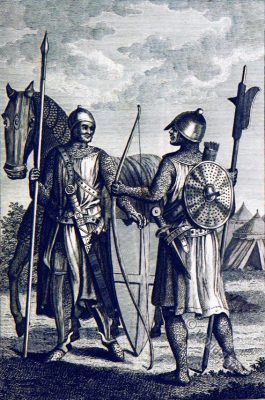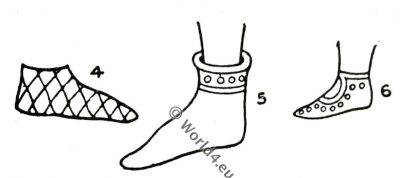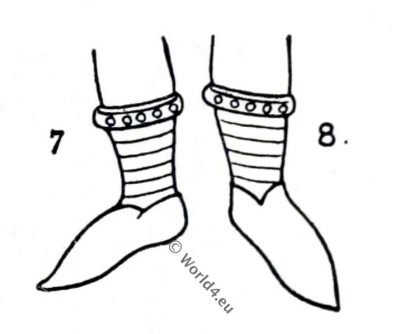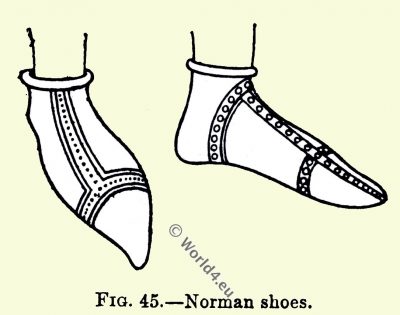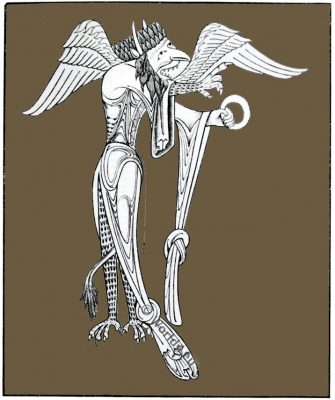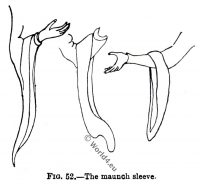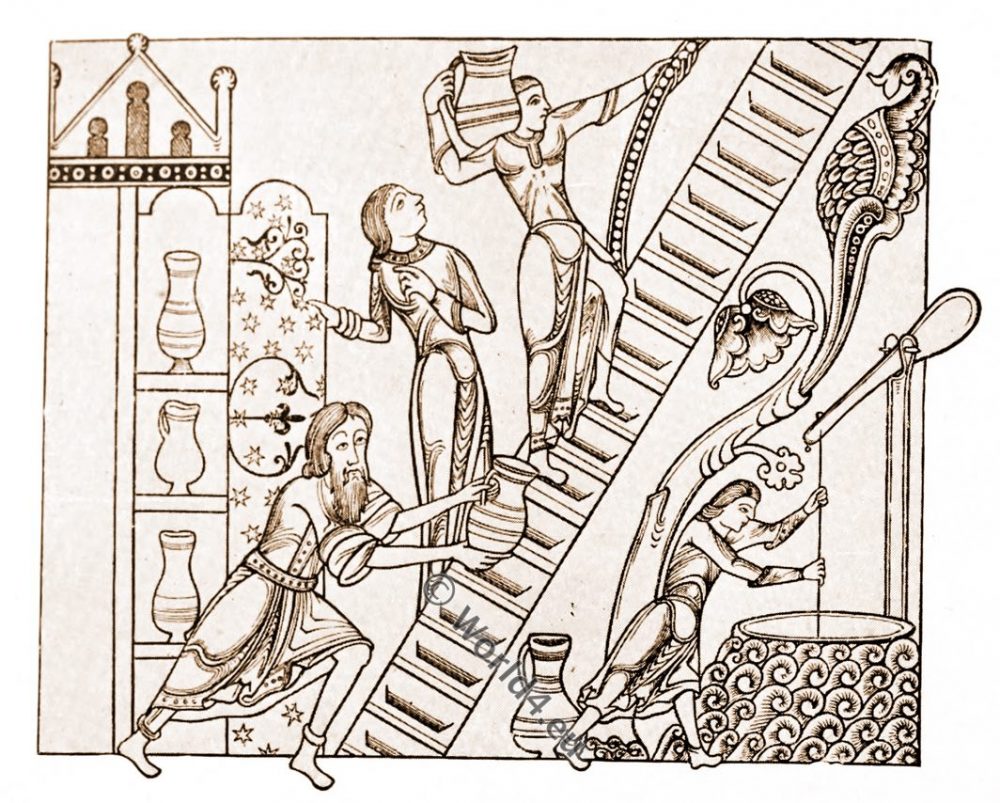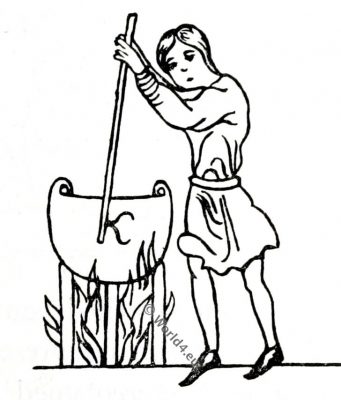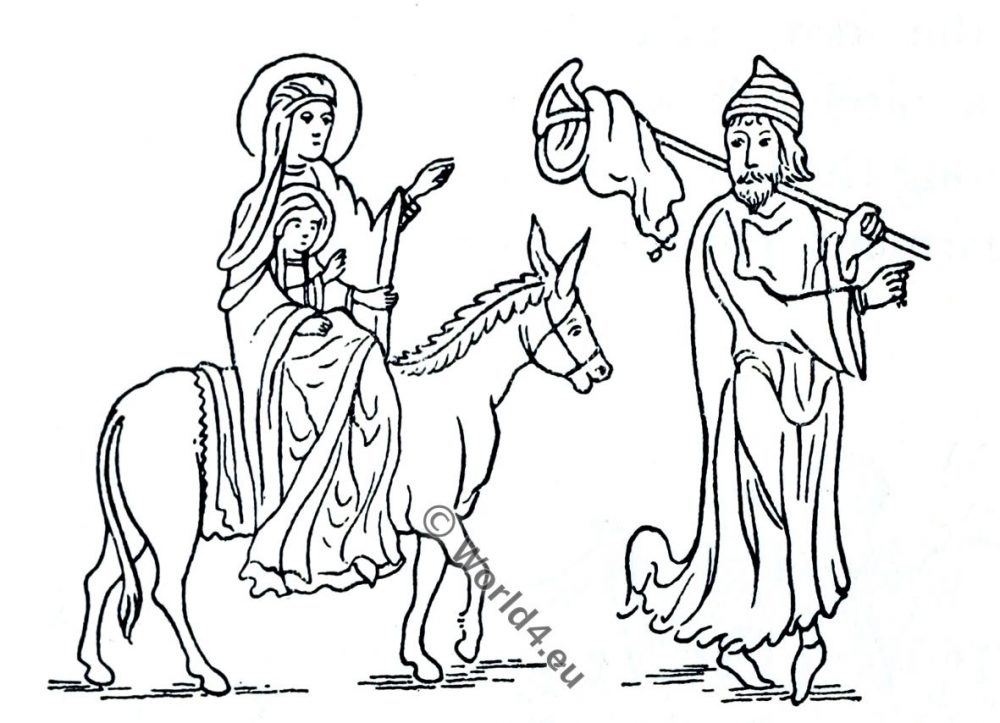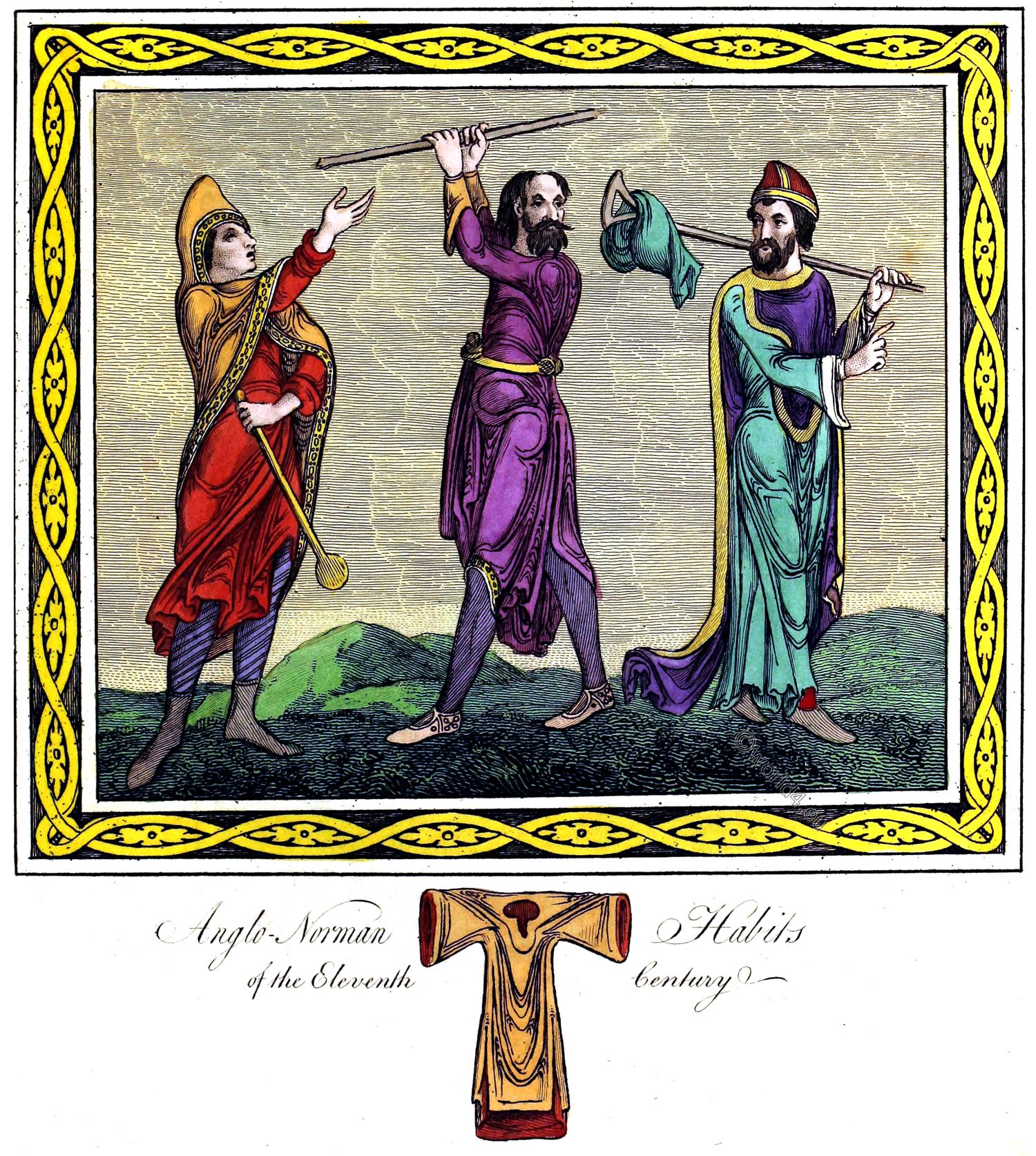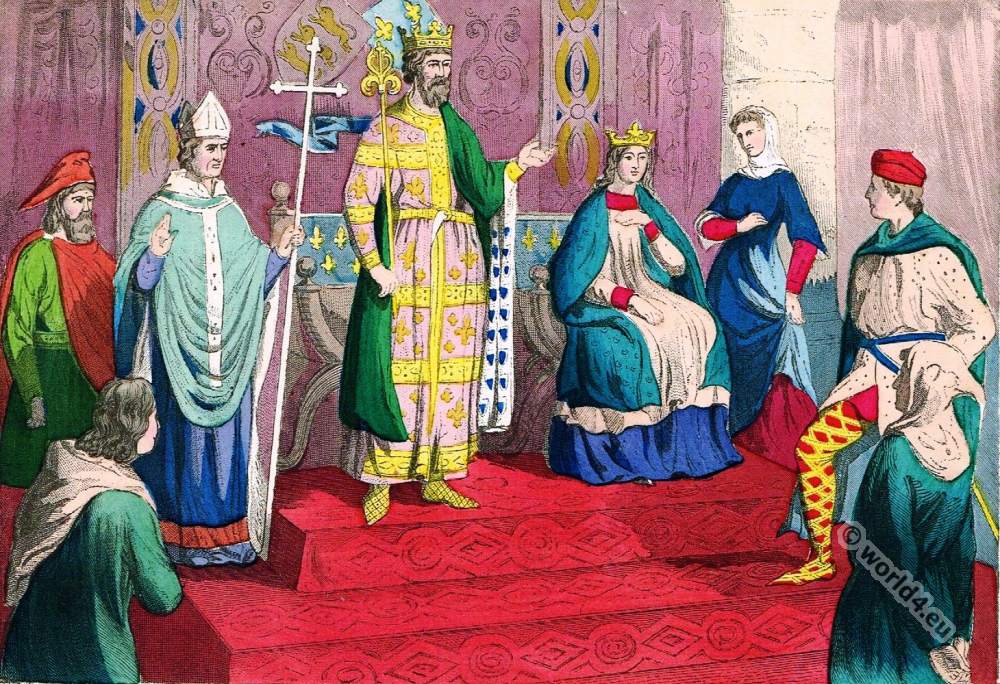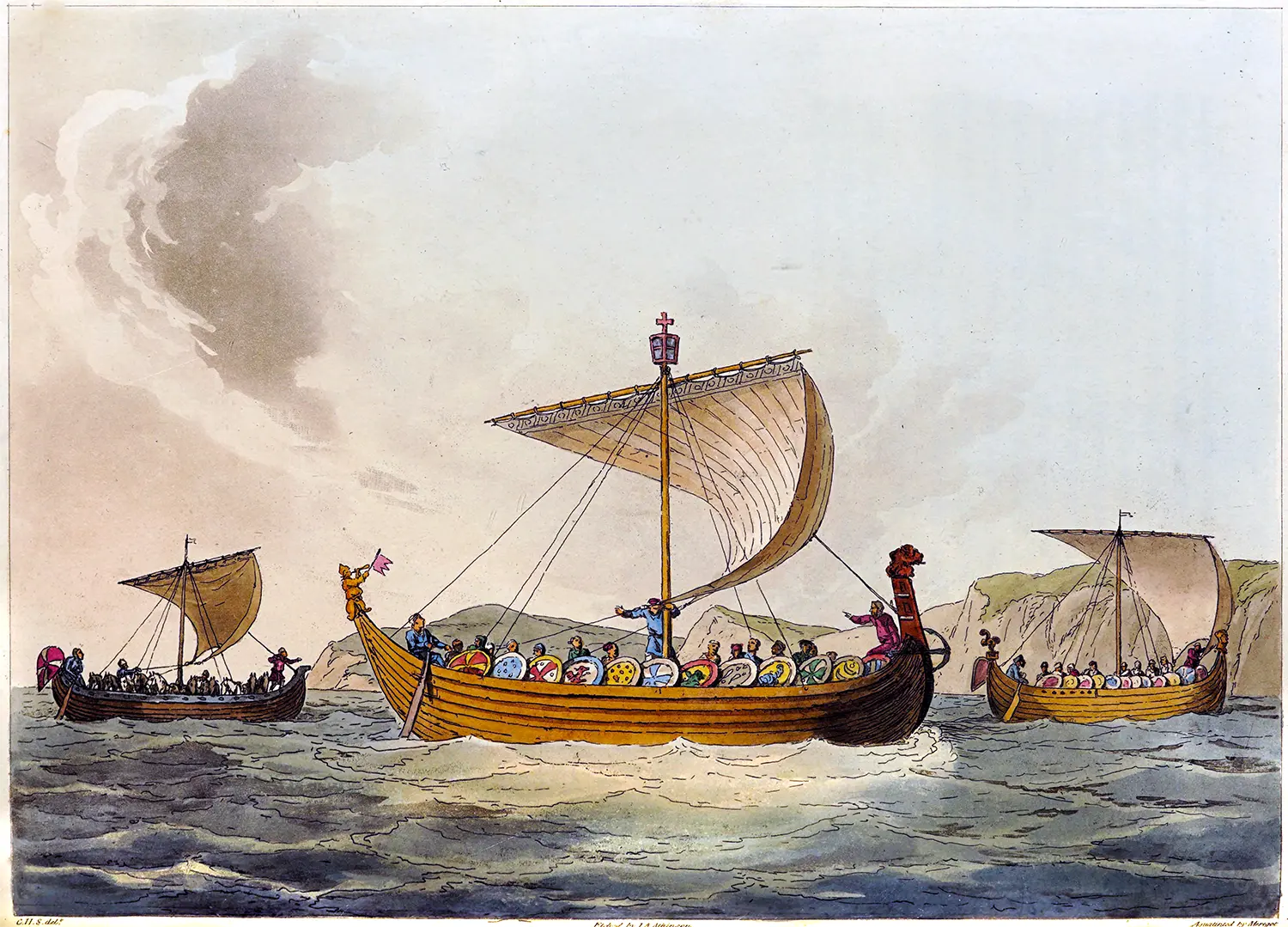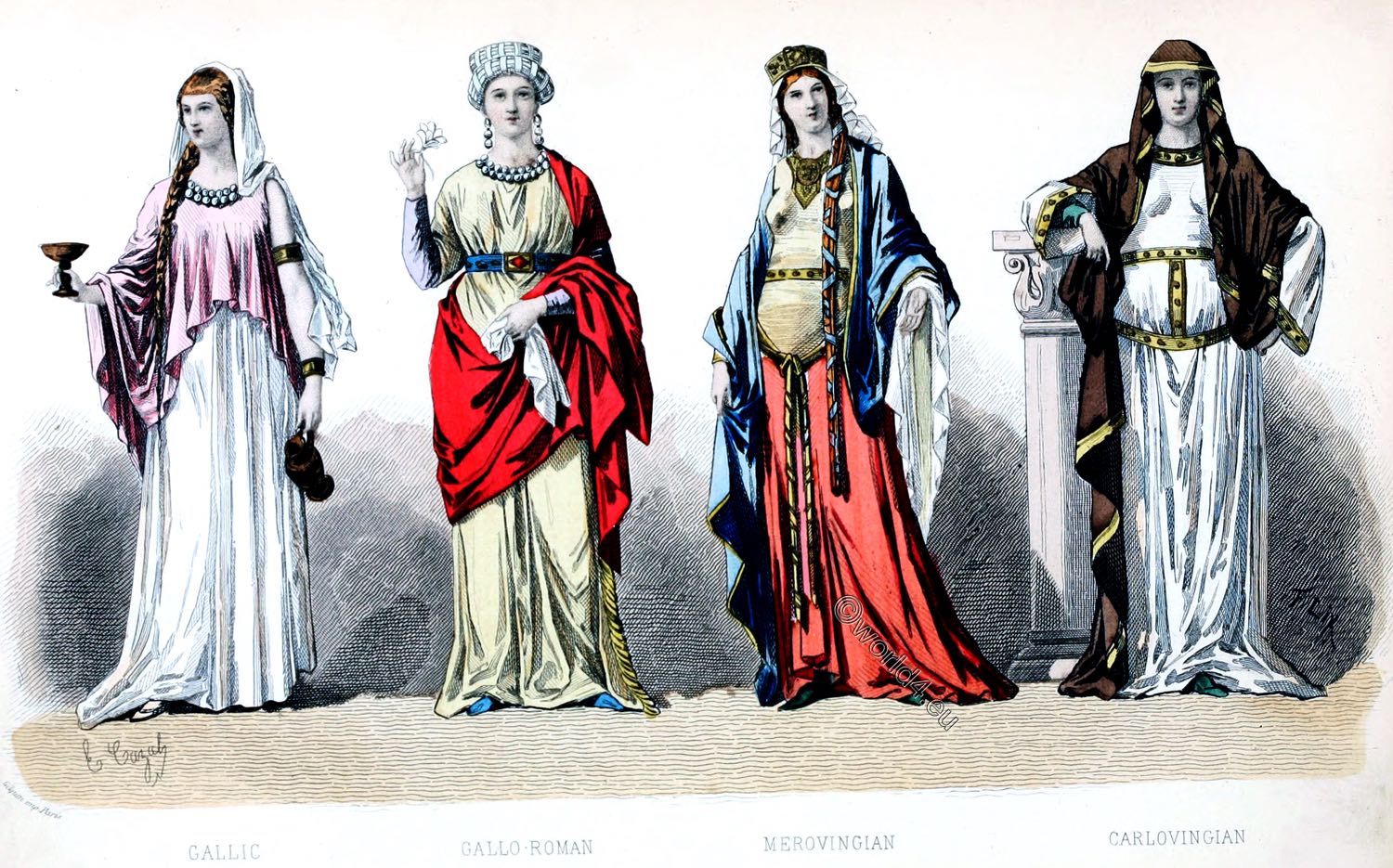Content:

Empress Matilda (also Empress Maude 1102 – 1167) was the first female regent of the kingdom of England, but was not crowned.
The Norman Period
William the Conqueror, 1066-1087.
by Mrs. Charles H. Ashdown.
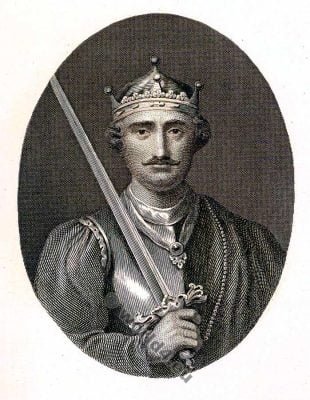
Introduction
Before proceeding with the main subject of this chapter, it may be advisable to say a few words of explanation respecting historical manuscripts, and the methods of delineation pursued by mediaeval artists.
We find that very few persons, apart from those in touch with the actual books, have the least idea what, say, “Cott. MS. Nero D vii.” implies; and as references have already been made, and will frequently be met with in succeeding chapters, the explanation may probably be acceptable.
It is the method adopted in the British Museum, the Bodleian Library, and other institutions for cataloguing the manuscripts in their possession. Thus “Cottonian MS.” signifies that the manuscript is part of the collection presented to the nation by Sir John Cotton in 1700; “Nero,” simply refers to a bust of that Emperor which stood over the bookcase in the original collection; “D” is the fourth shelf (in alphabetical order); and “vii.” is the place occupied by the book along the shelf.
Similarly “Roy. MS. C vii.” refers to the bequest of manuscripts by King George II. in 1757, and “Add. MSS.” refers to the large collection which has been acquired by Government grants.
With respect to the methods of delineation by mediaeval artists, it must be remembered that the latter were totally ignorant of any style of costume other than that prevailing in their own period.
The dress of the Greek and the Roman was as much a mystery to them as was that of the Jew at the time of our Lord; and as the manuscripts they wrote and illuminated invariably related to sacred or classical subjects, there was no alternative but to place the various characters in the dress of the period. To our eyes it would appear incongruous to represent Pontius Pilate habited in the garb a gentleman assumes when promenading Regent Street, or Joshua attired in the immaculate uniform of an officer in the Coldstream Guards; but to those who lived in the Middle Ages these anachronisms presented no ludicrous features.
Thus Moses appeared in the Saxon period (Add. MSS. 10,546) in the dress of a Thegn, while in Sloane MS. 346, written towards the close of the thirteenth century, the lawgiver appears in chain mail and plate, armed with sword and spear, and prancing upon a gaily caparisoned charger. This custom prevailed until the close of the fifteenth century, and it affords us the finest and most reliable examples of all kinds of costume, the most minute details being faithfully reproduced.
As a further example we will cite one of common knowledge. King Arthur of the Round Table is invariably represented in full plate armour of the 15th century, at which period the manuscripts were written; as is well known, he was a British prince who died in the 6th century. With the advent of the Norman Period we find no startling changes in costume, inasmuch as the Normans of both sexes were habited somewhat similarly to those of the conquered race.
There were, however, minute peculiarities which distinguished the Normans, and these had been adversely commented upon by the elder Saxons in the reign of Edward the Confessor when they perceived the younger generation imitating the speech, manners, and garb of the Normans at the King’s Court. “They shortened their tunics and trimmed their hair; they loaded their arms with golden bracelets, and entirely forgot their usual simplicity,” is recorded by monkish chroniclers.
THE MEN
The Tunic.
The essential garments affected by the Normans were the tunic, the super-tunic, and the mantle. The Tunic was a garment worn next to the skin by the lower classes, and over the just-au-corps among the upper. It was made of linen or fine cloth, and at the time of the Conquest did not reach below the knees, and was furnished with short sleeves. Among the upper classes this garment is never visible, nd it is simply from representations among the humbler people that we are aware of its existence.
The Super-Tunic.
This garment was similar to the tunica of the Saxons, but was worn much shorter; it is shown upon the Bayeux Tapestry, reaching to the knees. The sleeves were tight to the arms and long, terminating at the wrist with a small cuff. Embroidery was used at the neck and also round the hem.
The Mantle.
This differed but slightly from the Saxon; it was more voluminous, and in the early period was frequently longer than the tunic. It fastened up the front, or on either shoulder, precisely the same as in the previous period.
The Cap.
Upon the head of the civilians appears a small flat cap, with a band round the forehead (No. 1, Fig. 37); No. 2 is a very prevalent round skull-cap; No. 3 exemplifies the Norman pattern of the Phrygian shape, which, as will be seen by comparison, differs from the Saxon by coming well down the back of the head; in No. 4 we note a variety of the cowl as usually worn ; and in the four, almost every variety of head-gear is comprised.
The Chausses.
The tight coverings for the lower limbs worn by the Normans were continuous as far as the waist, and termed chausses; at times they were furnished with laces, in order to draw them closer to the body. Over these, various systems of cross-gartering were used (Fig. 38).
The Shoes.
The Bayeux Tapestry exhibits the plainest form of shoes worn by all persons represented upon it, no ornamental work being discernible upon any character. They are similar to Nos. 1 and 2 in Fig. 39, but are generally represented without the projecting border round the top.
The colours shown are yellow, blue, green, and red. As the period progressed they wore also short boots reaching above the ankle, with a plain band round the tops. The styles, however, became more elaborate, and some further examples are shown in Fig. 41.

THE WOMEN
The Couvre-chef Head-dress, 1066-1100.
During the reign of William the Conqueror the dress of the ladies to a great extent preserved the simplicity which characterised it upon their first landing in England. In the very few illuminations and descriptions which have come down to us from that period, we find no very marked deviation from the dress of the Saxon ladies; in fact the representation of one will, for all practical purposes, serve for the other.
We may remark, however, that the covering for the head, although precisely the same as the Saxon head-rail, was dignified with a new name, and became the couvre-chef.
William II., 1087-1100. Henry I., 1100-1135. Stephen, 1135-1154.
Civil Costume of the Men.
The reigns of these monarchs were distinguished by a love of display and ostentation in dress in remarkable contradistinction to that of the warlike Conqueror. King Rufus was fond of dressing in gorgeous apparel, and the rich Norman noblemen, battening upon the proceeds of their newly acquired English estates, were not one whit behind in following the example of their royal leader.
The Tunics, we are informed, were made so long and full that they lay upon the ground and cumbered the heels of the wearers (Fig. 42). The Super-Tunic was considerably lengthened, and the sleeves so developed as to cover the hands. In addition to the rich embroidery used upon the dress at the time of William I., the material of the garments now showed signs of ornamentation, especially during the latter part of the reign of Rufus, when the Oriental feeling began to develop.

The Crusades
The Crusades exerted an influence upon the costume of the Western nations of Europe which cannot be too strongly accentuated. For many years before the First Crusade in 1096 a more or less constant intercourse with Eastern nations had prevailed, by reason of the numerous pilgrims who had visited the Holy Sepulchre; but when streams of men constantly poured backwards from the battle-fields of Palestine, wounded, or sick, or tired of the struggle, they brought with them such overwhelming stores of Oriental taste and Eastern culture, that the costume prevailing in their own land appeared to them simple and barbaric.
Among the many beautiful materials brought home from the Orient, it is probable that samite found a place; it was sometimes entirely composed of silk, but frequently was interwoven with threads of gold and silver, and much embroidered or otherwise embellished with gold in a very costly manner.
This material was chiefly dedicated to sacred uses; but it was not confined to the Church however, for we know it was used by the Norman monarchs, the nobility, and ladies of high rank on particular occasions, when more than an ordinary display of pomp was required. It is highly probable that many other rich materials mentioned in the 13th century were introduced at this time, although they are not distinctly identified by name.
The Mantle of the period was worn short or long, according to the length of the super-tunic; among the nobility it was made of the finest cloth, and lined with rich furs.
The Cap.
During this period a modified form of the Phrygian shape was worn (Fig. 43, No. 1); but during inclement weather, or when travelling, a cloak, to which was attached a hood of the Phrygian shape, was in use, and was called by the Normans the Capa (No.2). An illumination of this date exhibits another kind of hat which prevailed (No. 3), similar to the cap worn by the modern carter.
The Shoe.
The extravagance in dress in the time of King Rufus was also exemplified in the shoes, for the twist given to the pointed toe of the boot during the reign of his father developed to an amazing extent during the reign of Rufus, while under Henry I. and Stephen the pike-toed boots and shoes excited the wrath of the monastic historians.
The ecclesiastics were strictly forbidden to copy the monstrosities which they condemned. One variety, termed Pigacia, had points like a scorpion’s tail, while we are told that a courtier stuffed his with tow, and caused them to curl round like a ram’s horns, thereby eliciting much admiration from his companions.
The general form may be gleaned from Fig. 44, taken from the seal of Richard, Constable of Chester in the reign of Stephen, which, though military, sufficiently exhibits it. They are now no longer shown black as in the previous reign, but ins* variably in colour, and decorated with bands (Fig. 45).
Cross – banded chausses continued to be in use, although they are seldom visible by reason of the long garments.
The brother of Rufus bore the name of Curt-Hose, but historians differ as to the reason for this appellation. It may be, however, that Robert, with soldier-like simplicity, refused to wear the exaggerated monstrosities he saw around him, and so obtained the nickname.
It is worth remembering that for various reasons the civil, military, and ecclesiastical costumes, both in England and upon the Continent, were precisely similar during the whole of the twelfth century, and that a distinct national costume, so far as civil dress is concerned, was not evolved by the English until the reign of Edward III.
A typical example of this is shown in the preceding figure of Geoffrey Plantagenet, Count of Anjou, dating from the middle of the twelfth century, who is represented in a Phrygian cap, a mantle lined with fur, and a close-fitting super-tunic over a long tunic which reaches the ground. The long hair flowing upon the shoulders is very characteristic of the period (Fig. 46).

The Women
The Coif-de-mailles Head-dress, 1100-1150.
The eccentricities in costume displayed by the nobles in the time of Rufus were speedily imitated by the ladies, who, however, proceeded to such extremes that they finally evolved a dress so fantastic and grotesque that it has seldom been exceeded.
The long hanging sleeves of the nobles appear to have given the cue to the gentler sex (Fig. 47), who forthwith commenced to exhibit a perfect craze for lengthening every part of their garments which permitted.
The Robe was more tight-fitting than in the preceding reign, and was lengthened fig. 47. – The sleeve, to such a preposterous extent that it lay in great folds upon the ground. In the Cott. MS. Nero C iv. a representation of his Satanic majesty is given in the form of a woman—a compliment to the ladies which the monastic illuminators were very fond of paying.
It is given here in Fig. 48, PL, and affords a very fair idea of the length of the prevailing skirts, inasmuch as it is seen to be knotted, and yet lying upon the ground.
The sleeve also manifests the lengthening tendency, and is duly knotted. Apart from this, we may venture to say that tight-lacing is by no means a modern evil, but was practised even earlier than the 12th century; the figure in question shows a corset fastening up in front with a long lace depending from it.
Fig. 51, PL, gives us no less than three varieties of the robe and its sleeves, also from Nero C iv.; the Virgin and Child, on their way to Egypt, being the first subject.
Read more: Fig. 51.— Virgin and Child, &c. Norman costume: Ladies of the 12th century.
She wears a sleeve which does not differ essentially from that of a monk’s gown, while the second and third figures have sleeves of the period. To the uninitiated the peculiar figure of the heraldic maunch is quite unintelligible (Figs. 49 and 50), but a careful comparison will at once simplify the difficulty.
A further development of the sleeve, called the pocketing variety, is shown in Fig. 52, in which the terminations are very largely distended.
The Mantle.
This varied but veryslightly from those used in the time of William I., as will be seen on referring to the illustrations.
The Head-dress.
The head-gear lost its primitive simplicity for a time in consequence of an extreme rise of militarism among the ladies, engendered by the enthusiasm then holding possession of the country consequent upon the Crusades.
Without actually discarding this head-dress, they so adapted it as to represent in a marked degree the coif-de-mailles, or head covering of chain mail worn by their warrior lords. This will be seen exemplified in Fig. 53, PL, where the couvre-chef (in this case of red material) is pulled tightly down upon the head and kept in place by a band of yellow embroidery round the forehead, thus outlining the face similarly to that shown in Fig. 54, a knight in coif-de-mailles.
This figure, which is an exact reproduction of one in an illuminated manuscript of the period, exhibits another trait of military feeling which is well worthy of notice.
The super-tunic is purposely cut short, in order to show a garment which is a replica of that worn by the knights under their heavy mail, to prevent the latter chafing the skin. It was termed the Gambeson, and was thickly quilted. The dove-tail device of the hem is probably the lady’s own design.
It is generally supposed that the Tabard was introduced as a garment for both sexes at this period, but as we have been able to find it represented only upon one female figure, we hesitate to state it as a certainty. The tabard, however, undoubtedly came into use at a very early period, and was probably copied from the monastic habit, being identical in shape with the scapular. Later the tabard took a very prominent place in civil, and especially in military, habits.
The Hair, coiffure.
The method of dressing the hair at this period was very remarkable, and is plainly shown in a number of illustrations. It was plaited into two tails, or otherwise divided, and each portion enclosed in a long tapering case, at times reaching nearly to the ground.
As a rule these were made of silk, and decorated in various ways, the ends bearing ornamental tassels. There is a strong suspicion that this coiffure prevailed among the Saxon ladies before the Conquest, but it cannot be definitely stated as such
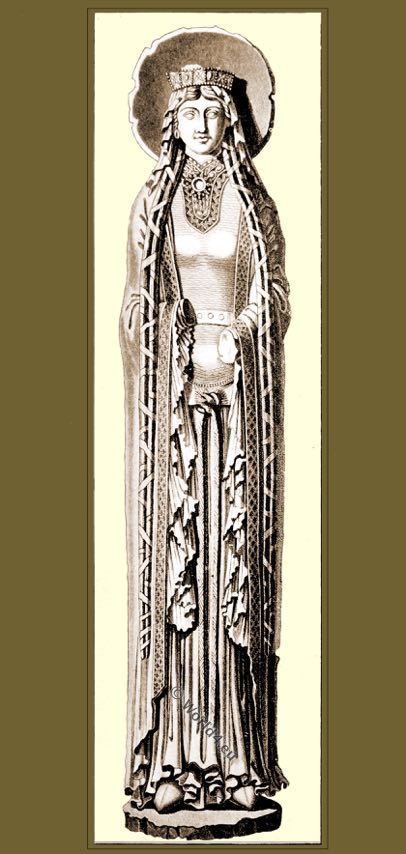
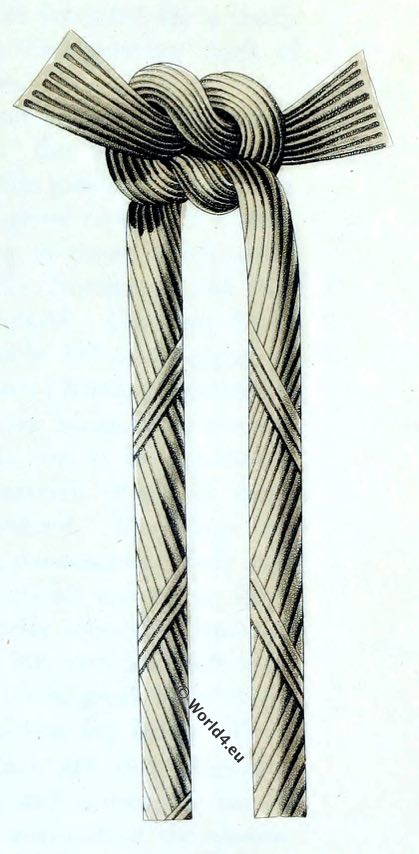
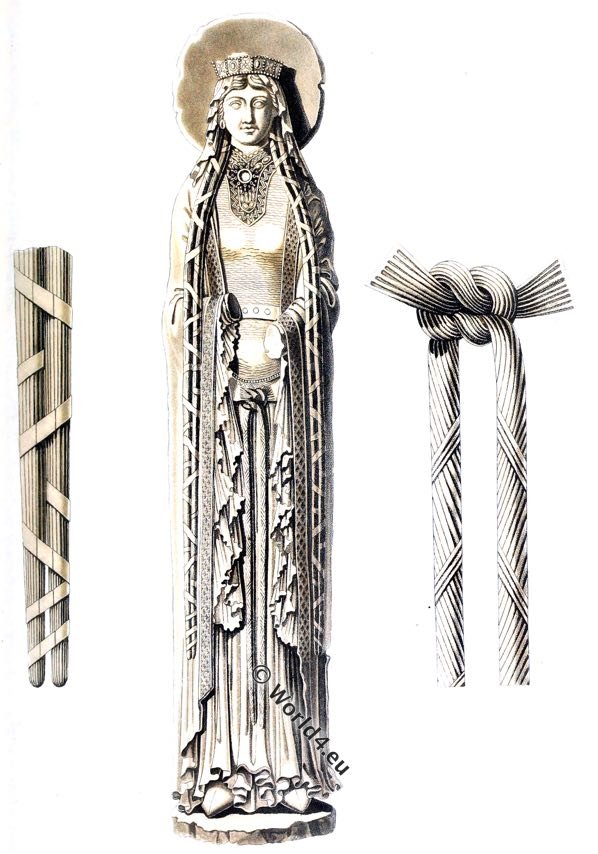
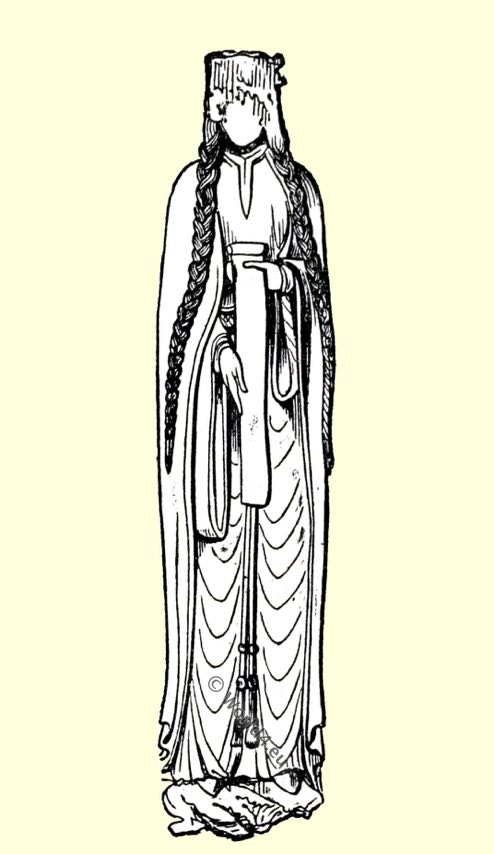
The two plaits preserved at Romsey, which were discovered in the Abbey Church in 1839, were taken from a coffin in which a woman of this early period had been buried. They are eighteen inches in length.
The effigy of Matilda, Queen of Henry I., at Rochester (Fig. 55), affords us an example of this fashion; the two long plaits descend to the hips; they are not encased, and the ends simply terminate in small locks.
Perhaps the finest example in existence is that shown upon the effigy of Queen Clotilda, from Corbeil, which is here reproduced (Fig. 56, PL). The plaits in this case reach below the knees; they are two in number on either side, and bound together by ribbons. That this style of doing the hair was not confined wholly to the upper classes is proved by a representation in a Psalter in St. Swithin’s Priory, Winchester, English 12th century, where a number of persons are shown in the place of torment, and the women represented, whether crowned or otherwise, have the two long tails.
This figure is not without interest as exemplifying the cloak ornamented by rich borders down the front. It is caught up over both arms, and only partially exposes the long hanging sleeves of this period, which are shown with an edging of pleated silk.
Upon referring back to Fig. 51, PL, it will be observed that the long encased plaits of the woman shown on the right exhibit the terminal appendages; the uncovered hair shown in this example is of the greatest rarity, and makes it a most remarkable figure.
The Shoes.
The shoes of Norman ladies are generally represented black in manuscripts, but considering that the men wore embroidered examples, sometimes elaborately ornamented with jewels, it is only reasonable to suppose that the ladies did the same. It must be carefully borne in mind that the distinctive civil costumes dealt with in these and succeeding chapters are essentially those of the wealthy and the well-to-do classes, and that they do not represent, except in a very remote degree, the general dress worn by the lower orders.
In works upon costume it will be found, as a rule, that the dress of the masses is but briefly referred to, if at all, and we venture to think that this is a mistake. A mental picture of England in the past, so far as costume is concerned, cannot be accurately imagined without a knowledge of the dress of all persons connected.
The general rule so far as it touches the mediaeval period appears to be, that the costumes of the classes of one generation is to a certain extent the costume of the masses in the next, though, of course, there are exceptions.
Read more: Fig. 57.— Anglo-Norman servants. 12th century. Cott. MS. Nero C.IV.: Ladies of the 12th century.
During the early Norman Period the dress of the Saxons preserved the same characteristics which had distinguished it for centuries (Fig. 57, PI.), and many features pertaining to it survived even to the times of the Lancastrian monarchs.
Many illustrations of rustics have been handed down to us. In Cott. MS. Jul. A vi., the figures seen harvesting in the fields, felling trees, hunting, &c, are precisely similar to those shown three centuries earlier, and the same remarks may be made of artificers, gardeners, &c, in another 11th century manuscript (Cott. MS. Claudius B iv.) slightly later in date, the only exception being the hair, which is rather longer.
As a rule the rustics worked in the open air with the head uncovered, but in one illumination, dating from the time of William I., a figure is shown with a hood over the head, which may be taken as a very early form of the capuchon which subsequently prevailed for so many centuries.
An exception also occurs in the case of the rustics appearing to Henry I. in his dream, where one holding the scythe is depicted wearing a hat of the form referred to previously. Another man grasping a pitchfork wears a cloak, which is very rarely shown among the lowest classes (Fig. 58).
The garment covering the body was usually of the simplest form that could be devised; a close jacket reaching from the throat to the knees and furnished with sleeves generally too long for the arms, and rucked in Saxon fashion at the wrists (Fig. 59). It was invariably made of the tanned skin of some animal, upon which the hair had been left to be worn outside.
This primitive garment, which was generally the only one worn amongst the lowest classes, was drawn in round the waist by a broad leather belt, which suspended a knife and other necessary articles. Shoes of a simple shape were always worn, and to this rugged simplicity, stockings of cloth and cross-gartering of leather were added by those in better circumstances.
The women of the lower classes were habited in as simple a manner as that which distinguished the men. A gown with sleeves, and reaching to the feet, with a piece of coarse linen swathed round the head after the manner of the rail or the couvre-chef, supplied a pattern which became almost stereotyped for three centuries. The hair was jealously guarded from exposure, as during the Saxon Period.
The accompanying woodcut (Fig. 60), representing Norman travellers of the middle class, may afford interesting details to the student.
Source:
- British costume by Mrs. Charles H. Ashdown.
- English costume by Diane Clayton Calthrop.
- Münchner Kostümbilder.
- English costume and fashion by Lewis Wingfield.
- Samuel Rush Meyrick. ‘A Critical Inquiry into Ancient Armour, as it existed in Europe, but particularly in England, from the Norman Conquest to the Reign of King Charles II’. London: John Dowding, circa 1830.
- Costumes civils et militaires des Français à travers les siècles. 1883. Author: Jean Baptiste Marie Augustin Challamel.
- Dresses and Decorations of the Middle Ages Vol 1., by Henry Shaw F.S.A. London William Pickering 1843.
Related
Discover more from World4 Costume Culture History
Subscribe to get the latest posts sent to your email.



